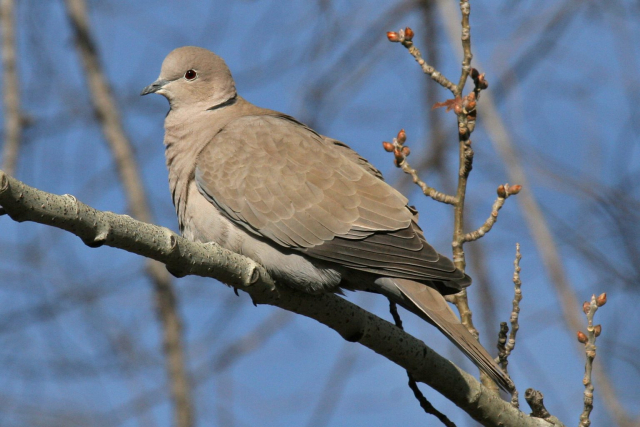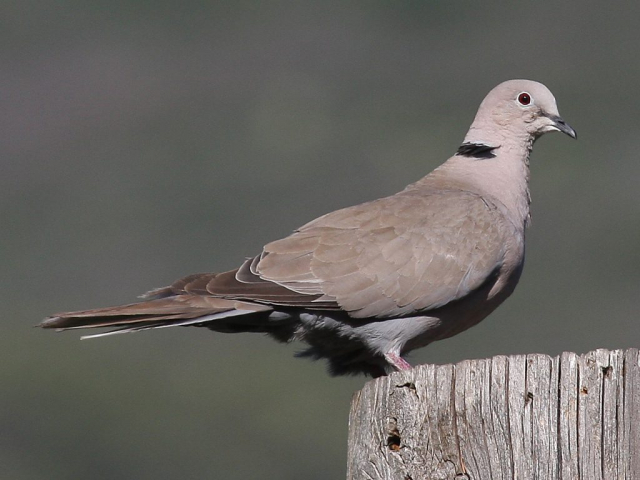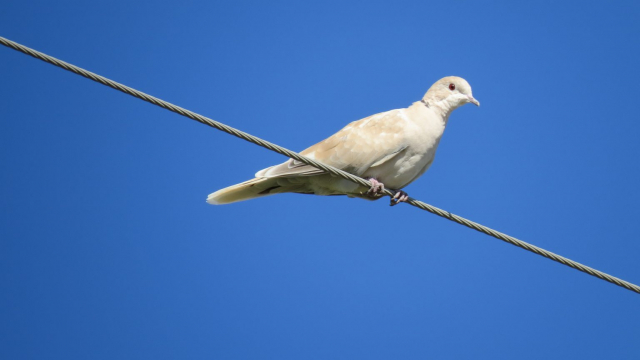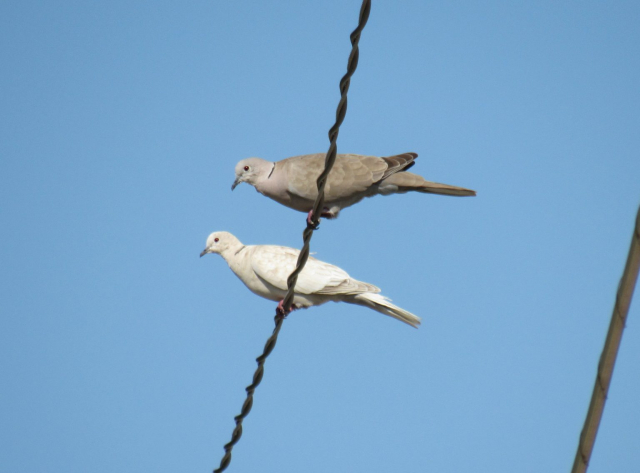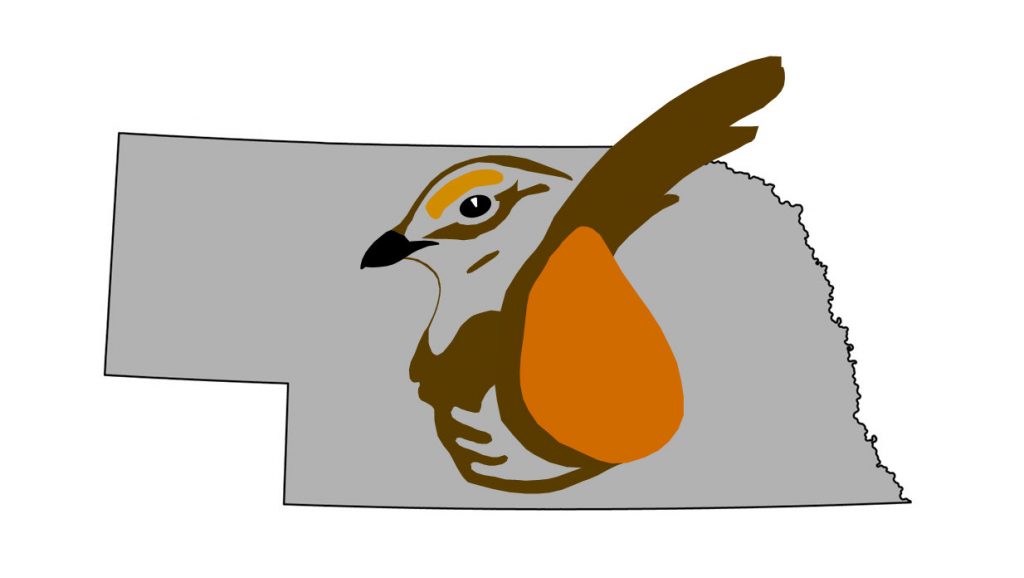Streptopelia decaocto
Status: Common, locally abundant, regular resident statewide.
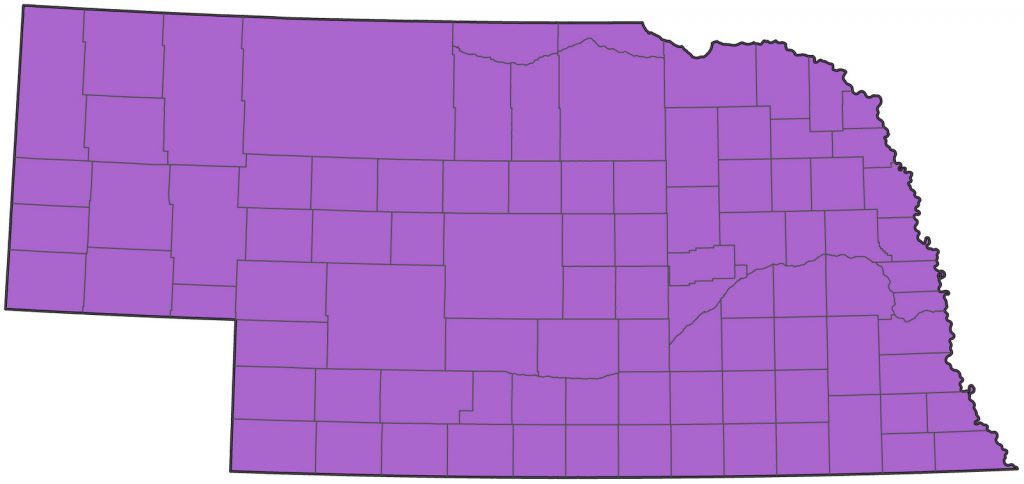
Documentation: Specimens: ZM-18428 (female) and 18429 (male), 29 Nov 2005 “found dead one day after blizzard” in Bassett, Rock Co.
Taxonomy: No subspecies are recognized within Eurasian S. decaocto (AviList 2025) since its split from Burmese Collared-Dove S. xanthocycla and elevation to species status (Romagosa 2020).
Introduced North American birds are decaocto (Romagosa 2020).
Numbers of wild birds may be augmented on occasion by released Ringed Turtle-Doves (see that species).
See hybrid account for Mourning X Eurasian Collared-Dove for discussion on putative hybrids between these two species.
Resident: Arrival, range expansion and increase in numbers by this species in Nebraska was discussed by Brogie and Silcock (2004). As of Mar 2001, it was “now residing in many of the larger towns in the Panhandle” (Stephen J. Dinsmore, personal communication), and occurred in numbers in and near Kearney, Buffalo Co. By spring 2004, it had been reported in 77 counties (Brogie and Silcock 2004), the main exceptions being in the Sandhills; the final county to record the species was Keya Paha, on 18 Feb 2007. In 2008 it was considered “common”, even in the Sandhills, although as of spring 2017 there are still few reports from Cherry Co. It is by far most common in rural towns in western Nebraska and has only become noticeable in the east since the early 2000s. According to Brogie and Silcock (2004), earliest records in the east were 23 Jul 1999 Pierce Co, 23 Jan 2000 Dakota Co, and 21 Feb 2000 Cass Co, and records prior to 2000 elsewhere were 11 Jul 1998 Nuckolls Co, 22 Aug 1998 York Co, and Nov 1999 Thayer Co.
An earlier report was of one in Cuming Co Jun 1995 by Dr David Mlnarik (eBird.org). Unfortunately, we consider this report unconfirmed as a first state record based on the lack of a photo and the identification by phone, which do not eliminate the more likely at the time possibility of the bird being a Ringed Turtle-Dove. The next report of an Eurasian Collared-Dove in the east was in 1999 (see above).
The first state record was of one at a feeder in Shelton, Buffalo Co 29 Nov 1997 (Brogie and Silcock 2004). The second state record and first breeding record was of a pair carrying nest material at the Newcomb residence in Kearney, Buffalo Co 22 Apr 1998; these birds had fledged two young by 19 May (Silcock and Jorgensen 1998a) and then re-nested, and by 24 Sep as many as nine birds were present in the neighborhood (Silcock and Jorgensen 1998b, 1998c). Nesting was attempted in Oct and Dec but was unsuccessful (Silcock and Jorgensen 1998c). Eight birds were still present Dec 1998-Feb 1999, and “lots” were reported into spring 2000.
Since these initial records, numbers increased dramatically, as reported on CBCs, most notably in the north (Norfolk) and west (Scottsbluff); in winter 2016-2017 Scottsbluff reported 1359 on 29 Dec 2017, a new count high, while across the state that same year totals were North Platte 166, Harlan County Reservoir 50, and Omaha 33, the latter a new count high. Since 2016-2017 however, numbers have declined dramatically in the west and north as well as more moderately elsewhere (Appendix Fig 1, below), while maintaining a gradual increase at low levels at Lincoln (Appendix Fig 2, below).
High non-CBC counts are 1500 at Kearney, Buffalo Co 2 Jan 2019, 1000 there 26 Dec 2017, 510 at Gering WTP, Scotts Bluff Co 30 Oct 2024, and 415 at Sidney, Cheyenne Co 7 Mar 2022, and, in the east, 243 in Lincoln, Lancaster Co 18 Oct 2019 and 231 at a grain elevator there 28 Sep 2018.
- Breeding Phenology:
- Displaying: 21 Feb
- Copulation: late Feb-24 Jul
- Nest-building: 30 Jan-28 Jul
Eggs: 21 Mar-13 Oct (Mollhoff 2022)
Nestlings: 29 Mar-27 Aug - Dependent Fledgling: 27 May-10 Oct
This species, like Rock Pigeon, may attempt to nest almost year-round, but mostly in Feb-Oct (Romagosa 2020). Four broods were raised in a Sidney, Cheyenne Co yard in 2006.
Comments: Escaped and released birds of the nominate subspecies decaocto (Romagosa 2020) on New Providence, Bahama Islands, in 1974 spread rapidly thereafter in the northern Caribbean and to Florida by the late 1970s (Smith 1987). Subsequently it has spread northwestward on the Great Plains and was first discovered in Nebraska at a feeder in Shelton, Buffalo Co 29 Nov 1997 (Brogie and Silcock 2004).
A specimen shot by a hunter in Stanton Co 16 Sep 2000 and mentioned in Brogie and Silcock (2004) cannot now be located.
Images
Abbreviations
CBC: Christmas Bird Count
Acknowledgement
Photograph (top) of an Eurasian Collared-Dove at Papillion, Sarpy Co on 11 Apr 2011 by Phil Swanson.
Appendix
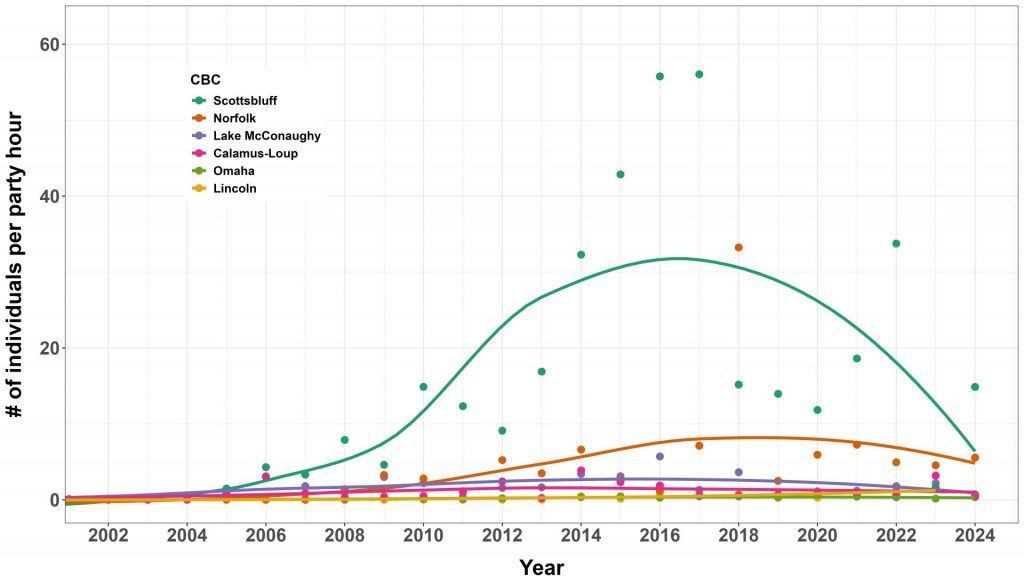
Figure 1. The number of Eurasian Collared-Doves recorded per party hour at selected CBCs in Nebraska. Points represent reported values and trend line created using locally weighted scatterplot (LOESS) smoothing. Data collected by volunteers and provided by National Audubon Society and the Nebraska Ornithologists Union. The Scottsbluff CBC has recorded markedly more birds and has seen a far greater rate of increase compared to other CBCs, but numbers have declined since 2017.
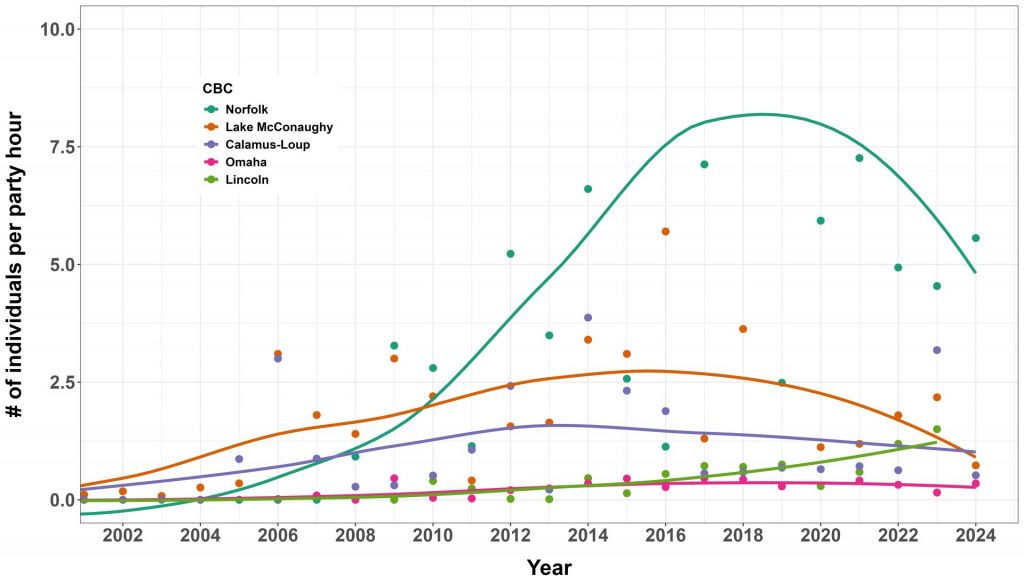
Figure 2. The number of Eurasian Collared-Doves recorded per party hour at selected CBCs in Nebraska. Figure 2 includes the same data as Figure 1 with the exception that the Scottsbluff CBC is excluded. Points represent reported values and trend line created using locally weighted scatterplot (LOESS) smoothing. Data collected by volunteers and provided by National Audubon Society and the Nebraska Ornithologists Union. The graphic shows largest increases at Norfolk, but number have declined since 2019. Smaller numbers have been observed in other CBCs, such as Lincoln and Omaha.
Literature Cited
AviList Core Team, 2025. AviList: The Global Avian Checklist, v2025. https://doi.org/10.2173/avilist.v2025.
Brogie, M.A., and W.R. Silcock. 2004. Eurasian Collared-Dove (Streptopelia decaocto) expansion in Nebraska: 1997-2003. NBR 72: 18-23.
Mollhoff, W.J. 2022. Nest records of Nebraska birds. Nebraska Ornithologists’ Union Occasional Paper Number 9.
Romagosa, C.M. 2020. Eurasian Collared-Dove (Streptopelia decaocto), version 1.0. In Birds of the World (S. M. Billerman, Editor). Cornell Lab of Ornithology, Ithaca, NY, USA. https://doi.org/10.2173/bow.eucdov.01.
Silcock, W.R., and J.G. Jorgensen. 1998a. Spring Field Report, March to May 1998. NBR 66: 30-55.
Silcock, W.R., and J.G. Jorgensen. 1998b. Summer Field Report, June-July 1998. NBR 66: 84- 100.
Silcock, W.R., and J.G. Jorgensen. 1998c. Fall Field Report, August to November 1998. NBR 66: 121-147.
Smith, P.W. 1987. The Eurasian Collared-Dove arrives in the Americas. American Birds 41: 1371-1379.
Wilson, J. 2018. ECDO-MODO – single.jpg and ECDO-MODO – group.jpg, accessed 8 February 2018.
Recommended Citation
Silcock, W.R., and J.G. Jorgensen. 2025. Eurasian Collared-Dove (Streptopelia decaocto). In Birds of Nebraska — Online. www.BirdsofNebraska.org
Birds of Nebraska – Online
Updated 1 Aug 2025
